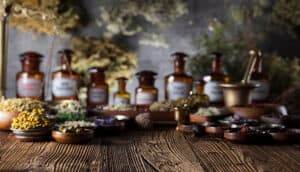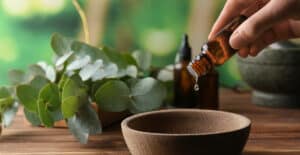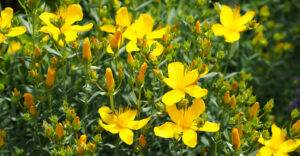The nervous system is a critical aspect of our health. It is the body’s command center that permeates and influences every organ, organ system, and musculoskeletal system. Not only does it affect every physiological function, but it’s also in direct relationship with our psychology and emotions.
With this in mind, we can start to understand the importance of nervous system health and balance because if the nervous system is “out of balance” or “burnt out,” it will ripple out and affect our physical, psychological, and emotional health.
Luckily, many medicinal plants can help strengthen, relax, and rebuild the nervous system. Before we get into the herbs themselves, it’s important to understand how the nervous system functions, what causes it to weaken and become dysfunctional, and how we can approach healing the nervous system through a holistic lens.
How The Nervous System Functions
The nervous system plays a critical role in human health, as it controls a vast range of bodily functions and responses, such as thoughts, movement, breathing, heart rate, the senses, digestion, how the body responds to stress, and so much more. In this way, it affects every aspect of our health.
For this article, I will focus on how the central nervous system responds to stress and how detrimental long-term stress (a.k.a overactive nervous system response) can affect long-term health and be a precursor to diseases.
How The Body Responds to Stress: Parasympathetic VS Sympathetic
Our central nervous system is composed of the parasympathetic and sympathetic nervous systems. When we encounter a stressful experience, whether it is psychological or physical, our body adjusts and adapts to confront the source of the stress.
It “confronts” the stress by switching to the sympathetic nervous system, which stimulates nervous system activity and activates the adrenal gland to release the hormone epinephrine (adrenaline) and norepinephrine. When epinephrine is released and circulates throughout the body, it increases heart rate, blood pressure, and surface constriction of blood vessels, which directs the blood away from the skin and to the muscles. When blood is directed away from the skin to the muscles, it delivers more oxygen and sugar.
These physiological responses give the body the energy it needs to run or fight, as in the fight-or-flight response (which now adds the freeze response). The parasympathetic nervous system is the natural state of being that our body returns to and is termed the rest and digest state. We need to be in the parasympathetic nervous system to relax, digest and metabolize nutrients, sleep, and feel peaceful and happy.
From a primal and instinctual perspective, the sympathetic response is highly beneficial and crucial for survival. However, when the threat continues, or we are unable to cope, the body releases cortisol to “stay on alert.” The problem is that when the sympathetic nervous system is chronically activated and switches on even when there isn’t a perceived threat, it can be detrimental to our health. Our bodies are not designed to be in the sympathetic nervous system for long periods. When we cannot cope with the increased and continual stress, we develop several psychological and physiological symptoms.
Examples of psychological symptoms include depression, anxiety, mood swings, insomnia, irritability, and inability to cope with daily stressors (such as traffic, work assignments, parenting, etc).
The physiological effects of long-term stress include damaged blood vessels and arteries and increased blood pressure (due to frequent epinephrine surges), which increases the risk of stroke and heart attack. Increased cortisol levels contribute to fat gain and increased appetite to build up the energy stores depleted in the stress response.
Chronic stress can also lead to inflammation, digestive complaints, hormone imbalance, lowered immunity, chronic pain, and a general state of decreased resistance. The physiological symptoms and diseases that develop from prolonged stress are more complex as they are specific to the individual’s genetics, learned body responses, physical weakness, and other factors.
Moreover, when there is chronic stress, the nervous system becomes depleted, weakened, or dysfunctional. This results in the sympathetic nervous system being triggered easily and more frequently. In other words, our nervous system isn’t able to strengthen and rebound when faced with too many stressors and becomes weakened over time.
When thinking about nervous system health, we want to consider how we can support this incredible system that is integral to every function of our body. We want to think about how we can best support the ability to switch back to the parasympathetic nervous system and how to maintain this state of rest and digest. In other words, we want to consider how to best cope with stress so our body can understand there isn’t a “threat” and we can rest, recuperate, and enjoy life.
Holistic Approach to Nervous System Balance
When healing any ailment or emotional imbalance, it’s prudent to take a holistic approach for sustainable healing.
The modern western medical system views the body and mind as separate and rarely acknowledges the spirit. Holistic herbalism, and holistic healing modules in general, view the body, mind, and spirit as one rather than separate parts. We are whole beings, and as such, our health needs to be viewed as a whole. In this way, if one part of the whole is imbalanced or experiencing dis-ease, all the other parts that make up the whole will also be affected. For example, if there is a physical imbalance that requires healing, the emotional, mental, and spiritual aspects of the individual also need to be accounted for, and vice versa.
Nervous system imbalances easily show this connection, as they often produce both physical and psychological symptoms that are clear to decipher. Anxiety is a common symptom of a nervous system imbalance, and anxiety includes a range of both emotional and physical symptoms, such as fear, impending doom, insomnia, digestive complaints, increased heart rate, and sweaty palms.
In this context, healing the nervous system requires several approaches that include physical, emotional, and spiritual therapies. There isn’t one “right” way to go about healing the nervous system, as each individual is unique, so their healing journey must be as well. That said, diet, exercise, lifestyle, thought patterns, habits, spirituality, and community support are areas of life that can be evaluated for healing the nervous system.
For example, along with medicinal herbs, one can implement support from a nutritionist, therapist, and/or spiritual leader/coach. For daily life, it’s helpful to start a self-care practice that incorporates mindful movement, meditation, and space for artistic expression. Find what brings you joy, and do more of that.
Most importantly, simply spending time outside in the fresh air, under the sun, and amongst the trees is one of the best treatments one can give their nervous system.
Herbs for The Nervous System: Understanding Nervines
The plant world is full of allies that support the nervous system. These plants are all placed under the general category of nervine: an herbal action term that means an herb has a direct effect on the nervous system.
Because so many herbs fall under this category, they are categorized further as nervine relaxants, nervine trophorestortatives, and nervine stimulants. You will also find herbs described as analgesic/anodyne (pain relieving), antispasmodic, hypnotic, anxiolytic (anti-anxiety), and antidepressant. All of these herbs fall under the category of nervine.
Many nervines have overlapping properties and may serve the nervous system in a few ways. For example, one herb may be a nervine that is a relaxant, hypnotic, and antispasmodic. While another herb may be anxiolytic, relaxant, and antidepressant. These terms are simply ways to further describe and understand the medicine of a plant and how it interacts with the body.
Nervine Relaxants
Medicinal plants with nervine relaxant properties sedate and calm the nervous system. If someone is experiencing anxiety or stress, and their sympathetic nervous system is activated, nervine relaxants can help switch the nervous system back to the parasympathetic nervous system. They can also help the individual cope with daily stressors in a more calm and non-reactionary way. In other words, they can help “take the edge off.”
Nervine relaxants range in strength and can be mild to strongly sedative. The stronger relaxants are termed hypnotics, as they can sedate the nervous system and cause one to feel tired and sluggish. Hypnotics are beneficial for pain, so many analgesics are also hypnotics. Examples of stronger nervine relaxants/hypnotics include skullcap (Scutellaria lateriflora), passionflower (Passiflora incarnata), valerian (Valeriana officinalis), California poppy (Eschscholzia californica), and hops (Humulus lupulus).
Mild nervine relaxants are gentle yet powerful allies that can be taken throughout the day without causing grogginess or sleepiness. Examples of mild nervine relaxants include lemon balm (Melissa officinalis), chamomile (Matricaria recutita), lavender (Lavandula spp.), St. John’s wort (Hypericum perforatum), and mugwort (Artemisia vulgaris).
Nervine Trophorestoratives
When it comes to herbs for nervous system balance, nervine trophorestoratives are the most important herbs to consider, as they have a direct restorative effect on the nervous system. Also referred to as nervine tonics, these remedies can rebuild, strengthen, and tonify a weak and worn-out nervous system.
Some of these medicinal plants don’t have much of a calming or sedative effect; rather, they are used as a daily tonic to help support and rebuild the nervous system over a period of time. This creates inner resilience that allows one to better cope with daily stressors, sleep well, relax, as well as pause and reflect more before reacting to triggering situations.
Examples of nervine trophorestoratives include milky oats (Avena sativa), skullcap (Scutellaria lateriflora), St. John’s wort (Hypericum perforatum), and ashwagandha (Withania somnifera).
Nervine Stimulants
Our society greatly approves of and encourages a busy lifestyle. With packed schedules and long work hours to make ends meet, we’ve come to rely on stimulants to help us stay awake and motivated. For this reason, we are the most familiar with this category of nervines and perhaps use them to the detriment of nervous system health.
Nervine stimulants, as the name implies, stimulate the nervous system through a variety of mechanisms, such as activating the adrenal glands to excrete epinephrine and norepinephrine, stimulate circulation, increase heart rate, and quicken and shorten the breath. As with chronic stress, overuse of nervine stimulants can cause the nervous system to weaken and become depleted over time.
Examples of nervine stimulants include coffee (Coffea arabica), cacao (Theobroma cacao), tea (Camellia sinensis), yerba mate (Ilex paraguariensis), sassafras (Sassafras albidum), and cola (Cola acuminata).
Herbs to Help Balance Your Nervous System
Now that we’ve set the foundation of understanding how the nervous system functions and what herbal nervines are, we can finally dive into the herbs themselves. The following list is just a *few* medicinal plants I want to highlight and is not a conclusive list by any means. Check out the end of this blog for a more comprehensive list of herbal nervines.
If you’re feeling called to work with herbs for nervous system balance, I recommend diving deeper into any herbs that stick out to you, even if they’re not on this list. The plants and our intuition are always speaking to us. With a listening ear to the subtle messages of the non-linear world, we can work with the medicine and therapies that are exactly what our body, mind, and spirit needs.
With that, let’s dive into some of my favorite and well-loved herbal remedies for nervous system balance.
Milky Oats (Avena sativa)
Milky oats is a powerful nervine trophorestorative. As such, it deserves a place as one of the top herbs for nervous system balance. In the context of balancing and healing the nervous system, milky oats is a formula unto itself.
If I’m crafting a formula to balance and rebuild the nervous system, milky oats is the foundation of that formula. All other nervines added are specific to the symptoms the individual is experiencing resulting from their nervous system imbalance. Milky oats is the foundation because of its profound effect on the nervous system and its ability to rebuild and strengthen worn-out nerves.
Many herbalists, including myself, consider milky oats the premier nervine trophorestorative in western herbalism because it’s efficacy in rebuilding the nervous system. It also has neutral energetics making it a valuable remedy for a wide range of people. Because it is not overly cooling or warming, a great number of individuals can take milky oats for a long time without affecting their body’s constitution. Plus, it is incredibly safe and gentle without any known contraindications.
Milky oats come from the same plant we make rolled oats or oatmeal, but they are harvested at a specific time before the seed hardens (which is then turned into ordinary ‘oats’). The nervine trophorestorative action of milky oats is derived from the latex found in fresh, green oat seeds. If you squeeze a green oat seed, and it exudes a white, milky substance (the latex) then you know it’s ready to harvest. This is why they are termed “milky” oats.
The rest of the plant is also medicinal, and it is referred to as “oat straw,” but it does not contain the same nervine trophorestorative constituents as the fresh green seeds. Rather, oat straw is a nutrient-dense herb and is used for providing nourishment to the body.
Milky oats doesn’t have a remarkable calming effect on the system, so it is used as a long-term, daily remedy to support nervous system balance. For this purpose, it’s recommended to take a daily tincture made from fresh seeds, as alcohol best extracts the white latex. Dried milky oats are not as medicinally potent and require a long decoction to extract their trophorestorative effects.
Skullcap (Scutellaria lateriflora)
Skullcap is a versatile nervine as it possesses trophorestorative, hypnotic, relaxant, and analgesic properties. I’ve found it to be extremely helpful when I can’t fall asleep due to excessive thoughts or anxiety and as a pain reliever for pounding headaches.
This is a bit of an interesting herb because it lends specific nervine properties depending on how it’s extracted/taken. The alcohol extraction lends more of a trophorestorative effect and much less of a hypnotic effect, while the infusion lends more of a calming, sedative effect. However, the herb has to steep in water that is below boiling temperature. Somehow, boiling water deactivates the hypnotic properties of skullcap, making it less medicinally active. These are some tips to keep in mind when working with skullcap if you feel called to do so.
Some specific indications of the ‘skullcap person’ include ungroundedness, nervousness, tension, and the overall experience of energy moving up and out (excess thoughts, spaciness). The bitterness of skullcap helps draw the energy down and in and helps to stimulate digestion through its bitter tonic effect. Even though skullcap has some bitterness, I don’t find it to be exceedingly bitter, and it lends an earthy pleasant taste (in my experience).
The combination of skullcap’s powerful nervine qualities and mild bitterness point it to being indicated for any time there are digestive complaints coupled with anxiety/stress. You’ll find that many nervine remedies also influence digestion, which is highly beneficial as nervous system burnout often affects digestion (since you need to be in the parasympathetic nervous system to digest food properly).
If you’re interested in becoming more familiar with skullcap, such as how to grow it and a more in-depth look at its medicinal profile, check out the skullcap growing guide.
St. John’s Wort (Hypericum perforatum)
This beautiful and historically-rich plant has gained popularity in recent years as an effective anti-depressant. While St. John’s wort certainly possesses anti-depressant qualities, it’s a complex medicinal that offers a wide range of therapeutic benefits. It is also a nervine trophorestorative, bitter tonic, hepatoprotective, anodyne, relaxant, and spiritually uplifting plant.
St. John’s wort is considered one of the top herbs for addressing nerve pain and is effectively used for sciatica, neuralgia, pinched nerves, spinal cord injuries, tooth pain, and shingles. St. John’s wort is a specific and reliable remedy whenever there is nerve-related pain. With this, we see that H. perforatum has an influence on the nerves themselves, as well as a restorative effect on the nervous system as a whole, making it an invaluable remedy to have on hand for a variety of conditions.
When it comes to addressing symptoms of nervous system imbalance, St. John’s wort has specific indications to look out for. Before I jump into those indications, it’s important to note that just because an herb is classified “anti-depressant” or “anti-anxiety,” that doesn’t mean it’s a “one size fits all” remedy. You want to match the herb to the person. St. John’s wort has specific personalities or states of being that it is more beneficial for as compared to other states of being.
I find that the words of herbalist Sajah Popham perfectly capture the essence of St. John’s wort medicine and who it is best indicated for:
“The pattern we see with St. John’s Wort is that it is to be used when someone feels entrapped in the darkness and they cannot find the light. They have often lost hope, faith, trust, belief, and the ability of their own willpower and strength to effect change in their lives. It is as if their inner light is dimming – not in the sense that they are dying, but rather the light of their consciousness […] The St. John’s wort person oftentimes lacks a connection to their instinctual self and their ability to trust themselves. This can be seen as a weakness in the solar plexus, or manipura chakra, (whose color is yellow just like St. John’s Wort flowers), and is typically accompanied by low willpower, self-esteem, confidence, and strength of character.”
If you’re feeling called to work with St. John’s wort, note it is contraindicated with the use of certain medications, including anti-depressants, contraceptives, immunosuppressants, and more. If you’re on medication, check with a qualified herbalist or a trusted physician to see if it’s safe for you to take St. John’s wort.
Holy Basil (Ocimum tenuiflorum)
I make holy basil tea whenever I need a warm, comforting, and soothing experience. Holy basil, also known as Tulsi, is an incredible and versatile medicinal herb viewed as a sacred plant in India and other parts of Asia. It has a calming and uplifting effect on the nervous system and is wonderfully soothing to feelings of overwhelm, grief, loneliness, anxiety, and sadness.
Holy basil is considered an adaptogen: a medicinal plant that has an overall balancing and strengthening effect on the body. These medicinals influence many organs and symptoms of the body, exerting a harmonizing and rebuilding effect in whatever form is needed. In holy basil’s case, it has an affinity for the nervous, respiratory, immune, cardiovascular, and digestive systems. From this extensive list, we can see there is much to be explored in how holy basil interacts and supports the many systems of the body.
A unique aspect of holy basil is its therapeutic influence on cognitive function and its ability to relax and calm the mind. Because of this, it is used to help with focus, mental clarity, motivation, and conditions of imbalance of the mind, such as ADHD, depression, and anxiety. This points to holy basil as a specific remedy for those whose nervous system imbalance results in difficulty focusing, scattered, anxious thoughts, and being easily distracted.
Lemon Balm (Melissa officinalis)
Lemon balm was one of the first medicinal plants I became acquainted with, and because of this, I will always have a deep fondness for its medicine. This lovely herb is delicious as a beverage tea, and its pleasant taste is part of its medicine: it helps one to enjoy the little things in life, to let loose, and to have fun.
Melissa officinalis is a gentle relaxing nervine commonly used as a daily support for symptoms of nervous system imbalance such as anxiety, depression, and irritability. It has a specific affinity for nervous system imbalances that affect the heart, such as heart palpitations and a racing heart. It is used in this capacity generally alongside other heart medicines such as motherwort (Leonurus cardiaca), hawthorn flower and berry (Crataegus spp.), and rose (rosa spp.).
Some herbalists, including myself, consider it a mild nervine trophorestorative. Used for some time alongside milky oats and other individual-specific nervines, it can produce remarkable calming, restorative, and uplifting effects. It is specifically indicated for those whose anxiety or tension affects the heart and those who tend to take life too seriously. In this way, lemon balm is an energetic medicine for the inner child who isn’t allowed to come to the surface and interact with life. In other words, there’s a loss of awe, wonder, and “child-like curiosity” for the world around them. In this way, I feel lemon balm helps to bring one’s attention to the present moment and to see the beauty and magic in the seemingly “mundane.”
To practice this, simply make yourself a lemon balm tea, and then take a few minutes to allow yourself to be present with its aroma and taste. I like to stand before a window when I do this, observing the beauty of the natural world, and I allow the medicine of lemon balm to permeate my being. It’s amazing how joyful and lighter I feel afterward. Then, I let that experience carry me through my day.
If you want to learn more about lemon balm, including how to grow it and enjoy its medicine, check out the lemon balm growing guide!
Herbs for Nervous System Balance: Final Thoughts
A vast world of herbal medicine supports and balances the nervous system. These incredible nervines help calm, rebuild, and sedate the nerves, producing remarkable and versatile effects that are used for a range of conditions. Anything from pain, insomnia, anxiety, depression, or full-blown nervous system burn-out, there’s a medicinal herb there to support it.
Because several medicinal plants fall under the category of nervine, it’s helpful to allow intuition to lead the way in discovering which nervine is most indicated for you and your health. To pull things all together, here’s a list of several herbs for each nervine category and subsequent categories. If any of these sticks out, I encourage you to research them further and experience the plant’s medicine for yourself.
Nervine Relaxants
- Ashwagandha (Withania somnifera)
- Blue Vervain (Verbena hastata)
- Borage (Borago officinalis)
- Catnip (Nepeta cataria)
- Chamomile (Matricaria recutita)
- Damiana (Turnera diffusa)
- Hawthorn flower (Crataegus spp.)
- Holy Basil (Ocimum tenuiflorum)
- Lavender (Lavandula angustifolia)
- Lemon Balm (Melissa officinalis)
- Linden (Tilia europea)
- Mimosa (Albizia julibrissin)
- Motherwort (Leonurus cardiaca)
- Mugwort (Artemesia vulgaris)
- Pulsatilla (Anemone pulsatilla)
- St. John’s wort (Hypericum perforatum)
- Wood Betony (Stachys officinalis)
Nervine Hypnotics
- California Poppy (Eschscholzia californica)
- Hops (Humulus lupulus)
- Jamaican Dogwood (Piscidia erythrina)
- Kava-Kava (Piper methysticum)
- Passionflower (Passiflora incarnata)
- Pedicularis (Pedicularis spp.)
- Skullcap (Scutellaria lateriflora)
- Valerian (Valeriana officinalis)
- Wild Lettuce (Lactuca virosa, L. scariola)
Nervine Trophorestoratives
- Ashwagandha (Withania somnifera)
- Damiana (Turnera diffusa)
- Gotu Kola (Centella asiatica)
- Lemon Balm (Melissa officinalis)
- Lion’s Mane Mushroom (Hericium erinaceus)
- Milky Oats (Avena sativa)
- Reishi mushroom (Ganoderma spp.)
- Skullcap (Scutellaria lateriflora)
- St. John’s wort (Hypericum perforatum)
- Wood betony (Stachys officinalis)
Anti-Spasmodic
- Black Cohosh (Actaea racemosa)
- Black Haw (Viburnum prunifolium)
- Blue Vervain (Verbena hastata)
- Crampbark (Viburnum opulus)
- Lobelia (Lobelia inflata)
- Motherwort (Leonurus cardiaca)
- Pedicularis (Pedicularis spp.)
- Pulsatilla (Anemone pulsatilla)
- Valerian (Valeriana officinalis)
Anodyne/Analgesic
- California Poppy (Eschscholzia californica)
- Jamaican Dogwood (Piscidia erythrina)
- Kava-Kava (Piper methysticum)
- Pedicularis (Pedicularis spp.)
- Prickly Ash (Zanothoxylum americanum)
- Skullcap (Scutellaria lateriflora)
- St. John’s wort (Hypericum perforatum)
- Wild Lettuce (Lactuca virosa, L. scariola)
- Valerian (Valeriana officinalis)
Note: Almost all antispasmodics are also analgesics and vice versa.






